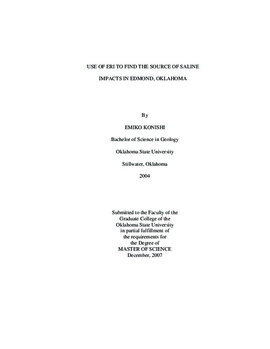| dc.contributor.advisor | Halihan, Todd | |
| dc.contributor.author | Konishi, Emiko | |
| dc.date.accessioned | 2014-03-14T21:51:59Z | |
| dc.date.available | 2014-03-14T21:51:59Z | |
| dc.date.issued | 2007-12-01 | |
| dc.identifier.uri | https://hdl.handle.net/11244/8032 | |
| dc.description.abstract | Major portions of Edmond, Oklahoma were once covered by oilfields. The rapid urbanization of Edmond has caused residential and commercial areas to expand over former oil and gas exploration sites. The residential areas have found salt water contamination in water supply wells at 150 feet depth. Electrical Resistivity Imaging (ERI) was selected as a primary sampling method in this investigation because of its portable, economical, and practicable advantages in an urban area. In this study, several ERI lines were collected to determine how efficiently advanced ERI techniques can delineate the extent and cause of impacted ground water, which may be caused by previous and/or active petroleum activities, specifically salt water floods and the piping that is used as part of these systems. In addition to the field surveys, the forward models are employed to determine anticipated pipe patterns in ERI datasets. The results of the forward models were applied into the field data with known and unknown pipe locations. The ERI survey method was a practical technique to determine anomalous regions of the subsurface that have either higher resistivities or lower resistivities than surrounding formation materials. However, this method could not immediately confirm the composition and/or cause of specific anomalies (i.e., whether anomalies are caused by variations in geology/lithology, moisture content changes or other naturally occurring heterogeneities; or if they are caused by the presence of impacts to soils/groundwater in the subsurface). The resistivity models indicated that conductive features (i.e. metal pipe, utilities, and saline fluid) in subsurface could be located and distinguished by application of forward and a-priori inversion models. | |
| dc.format | application/pdf | |
| dc.language | en_US | |
| dc.publisher | Oklahoma State University | |
| dc.rights | Copyright is held by the author who has granted the Oklahoma State University Library the non-exclusive right to share this material in its institutional repository. Contact Digital Library Services at lib-dls@okstate.edu or 405-744-9161 for the permission policy on the use, reproduction or distribution of this material. | |
| dc.title | Use of Eri to Find the Source of Saline Impacts in Edmond, Oklahoma | |
| dc.type | text | |
| dc.contributor.committeeMember | Puckette, James | |
| dc.contributor.committeeMember | Simms, Alex | |
| osu.filename | Konishi_okstate_0664M_2590.pdf | |
| osu.college | Arts and Sciences | |
| osu.accesstype | Open Access | |
| dc.description.department | Boone Pickens School of Geology | |
| dc.type.genre | Thesis | |
